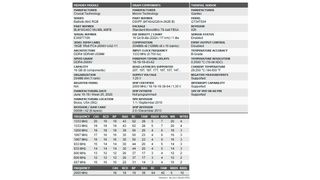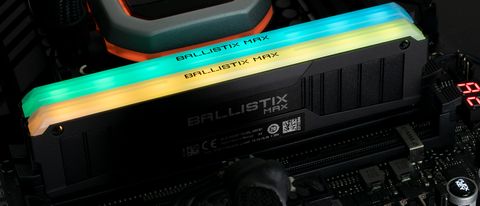Tom's Hardware Verdict
The out-of-the-box performance for the Ballistix Max RGB DDR4-4000 C18 isn't great, especially given it's high price. However, there's opportunity to improve if you're willing to invest time into manual tweaking.
Pros
- +
Can run at CAS Latency 16
- +
Sleek, non-intrusive design
- +
Replaceable light bar
Cons
- -
Poor XMP performance
- -
Requires fine tuning to shine
Why you can trust Tom's Hardware
Crucial's Ballistix Max RGB portfolio aims to appease users on the more demanding end of the spectrum. As a result, the Ballistix Max RGB series simply comes in DDR4-4000 and DDR4-4400 flavors, and in capacities of 16GB (2x8GB) or 32GB (2x16GB). Its speeds aren't as jaw-dropping as the company's record-breaking DDR4-5100, but it's still plenty speedy for the vast majority of gamers -- at least on paper.



The Ballistix Max RGB doesn't resort to fancy heatsinks or excessive RGB lighting to draw your attention. On the contrary, the memory modules feature a low-profile aluminium heat spreader with a discrete RGB light bar. Unlike the normal Ballistix (RGB) memory kits that are available in white, black and red, the Ballistix Max (RGB) only comes in a black trim.
Despite the addition of the light bar, the Ballistix Max RGB continues to measure 39.17mm (1.54 inches) in height, just like the other Ballistix iterations. A total of 16 RGB LEDs, which are divided into eight zones, lights up the Ballistix Max RGB. What makes the Ballistix Max RGB truely unique is the option to replace the light bar with your own custom, 3D-printed design. Of course, Crucial provides the necessary 3D files to do so on the company's website.
There are two ways to play around with the Ballistix Max RGB's lighting. You can use Crucial's Ballistix M.O.D. (Memory Overview Display) software or your motherboard's RGB software. If you prefer the latter, it's important to keep in mind that only Asus Aura Sync, MSI Mystic Light Sync and Gigabyte RGB Fusion 2.0 can control the Ballistix Max RGB.

Each Ballistix Max RGB memory module from this kit is 16GB in capacity and features an eight-layer PCB. Sporting a single-rank design, the memory modules utilize Micron's D9XPF (MT40A2G8VA-062E:B) integrated circuits (ICs).
At stock, the Ballistix Max RGB memory modules will operate at DDR4-2666 with 19-19-19-43 timings. If you're not into manual tweaking, the memory modules sport a single XMP profile that will automatically configure the frequency and timings to DDR4-4000 and 18-19-19-39, respectively, with a 1.35V DRAM voltage. For more on timings and frequency considerations, see our PC Memory 101 feature, as well as our How to Shop for RAM story.
Comparison Hardware
| Memory Kit | Part Number | Capacity | Data Rate | Primary Timings | Voltage | Warranty |
|---|---|---|---|---|---|---|
| G.Skill Trident Z Neo | F4-3600C16D-32GTZN | 2 x 16GB | DDR4-3600 (XMP) | 16-16-16-36 (2T) | 1.35 Volts | Lifetime |
| Crucial Ballistix Max RGB | BLM2K16G40C18U4BL | 2 x 16GB | DDR4-4000 (XMP) | 18-19-19-39 (2T) | 1.35 Volts | Lifetime |
| G.Skill Trident Z Royal | F4-4000C17D-32GTRGB | 2 x 16GB | DDR4-4000 (XMP) | 17-18-18-38 (2T) | 1.40 Volts | Lifetime |
| Klevv Bolt XR | KD4AGU880-36A180C | 2 x 16GB | DDR4-3600 (XMP) | 18-22-22-42 (2T) | 1.35 Volts | Lifetime |
Our Intel test system consists of an Intel Core i7-10700K and Asus ROG Maximus XII Apex on the 0707 firmware. On the opposite end, the AMD testbed leverages an AMD Ryzen 5 3600 and ASRock B550 Taichi with the 1.30 firmware. The MSI GeForce RTX 2080 Ti Gaming Trio handles the graphical duties on both platforms.
Intel Performance



















The Ballistix Max RGB kit ranked last on the CPU performance charts, though it performed particularly well in the Microsoft Office tests. The Ballistix Max RGB's standing improved in the gaming tests and was faster than the Bolt XR DDR4-3600 C18 memory kit.
AMD Performance



















The Ballistix Max RGB didn't have a better showing on the AMD platform either. The memory kit came in last in both CPU performance and gaming RAM benchmarks. It's really not the memory's fault though. AMD's Ryzen 3000 processors typically allow synchronous operation between the Infinity Fabric clock (FCLK) and memory clock (MCLK) up to DDR4-3600, so anything past that tends to result in worse performance in many types of workloads due to the increase latency.
Still, the Ballistix Max RGB delivered the best performance in Cinebench R20, HandBrake x265 and 7-Zip decompression workloads.
Overclocking and Latency Tuning



The Ballistix Max RGB requires 1.35V to run at the advertised DDR4-4000 speed. By increasing the DRAM voltage to 1.45V, we got another 200 MHz out of the memory kit. We had to increase the timings to 20-20-20-40 to achieve stability though.
Lowest Stable Timings
| Memory Kit | DDR4-3600 (1.45V) | DDR4-4000 (1.45V) | DDR4-4133 (1.45) | DDR4-4200 (1.45) |
|---|---|---|---|---|
| G.Skill Trident Z Neo DDR4-3600 C16 | 13-14-14-35 (2T) | N/A | N/A | 19-19-19-39 (2T) |
| Crucial Ballistix Max RGB DDR4-4000 C18 | N/A | 16-19-19-39 (2T) | N/A | 20-20-20-40 (2T) |
| G.Skill Trident Z Royal DDR4-4000 C17 | N/A | 15-16-16-36 (2T) | 18-19-19-39 (2T) | N/A |
| Klevv Bolt XR DDR4-3600 C18 | 16-19-19-39 (2T) | N/A | 18-22-22-42 (2T) | N/A |
The Ballistix Max RGB was more generous when it comes to optimizing the timings at DDR4-4000. We were able to get the CAS Latency from 18 down to 16 clock cyles. However, the tRCD, tRP and tRAS timings wouldn't allow any adjustments.
Bottom Line
With a CAS Latency of 18, the Ballistix Max RGB DDR4-4000 isn't the worst memory kit in its category. But logically, it won't perform on par with similar offerings at C16 or C15. The Ballistix Max RGB DDR4-4000 will struggle behind less-expensive offerings like the DDR4-3600 C16 memory kits. The only card up the Ballistix Max RGB's sleeve is the wiggling room. It was possible for us to lower the CAS Latency from 18 to 16, which will give the Ballistix Max RGB a nice push in regards to performance. But of course, overclocking mileage is not something that neither we or Crucial can guarantee.
The normal price tag for Crucial's Ballistix Max RGB DDR4-4000 C18 memory kit is $399.99 although sometimes you can find it for as low as $369. In that price point, the Ballistix Max RGB isn't so attractive for the average consumer. If you're looking for the best XMP performance, there are better options out there, such as the Trident Z Neo DDR4-3600 C16 memory kit that retails for $249.99.

Zhiye Liu is a Freelance News Writer at Tom’s Hardware US. Although he loves everything that’s hardware, he has a soft spot for CPUs, GPUs, and RAM.
-
tiggers97 Bit of warning for people considering the regular Micron/Crucial Ballistix 2x16gb 3600. It seems that the older memory was dual rank and Rev E. But sometime in the near past, they have switched over to single rank and Rev B. This is disappointing (if true) as the dual rank 2x16gb are ideal. No idea if it is 100% across the board for all 2x16gb 3600 kits, or if certain manufacturers for Micron are making single rank, and others making dual rank.Reply
My self, I cannot get an answer from Crucial on what is going on. And I know a lot of people are buying this memory expecting dual rank for their new Ryzen 5000 series builds.
Can TomsHardware use their journalistic tech influence to find out what exactly is going on? And which memory modules exactly (2x16gb as well) are single vs dual rank for their Ballistix line?
